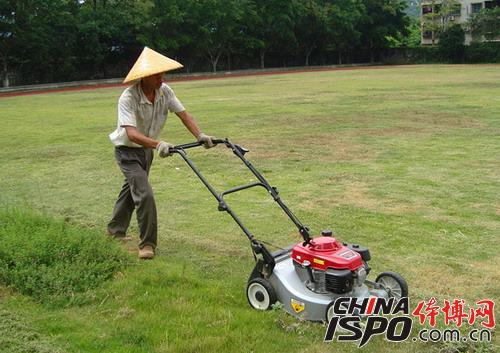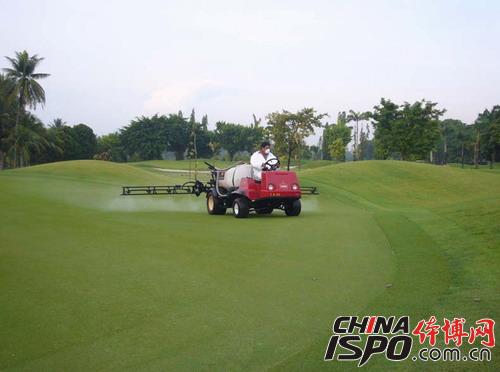Although the vitality of the lawn is very strong, but it can not be ignored after the establishment, or need the careful cultivation of managers, in order to grow healthily. Many turfgrass cultivation and maintenance personnel often overlook the maintenance and management in the future. As a result, the turfgrass after planting is different from the expected results. Therefore, to master the following methods of turfgrass management in order to maintain the beauty of the turf and extend its life.
One, pruning

mowing the lawn
The first step in turfgrass management, of course, is to start with pruning. In principle, the trim length of the lawn should not exceed one-third of the grass length. Regarding the height of stubble, reference can be made to the following table data, but due to factors such as the differences in use of the lawn and the cost constraints, the height can be adjusted appropriately.
lawn | Height (unit: cm) |
Premature | 3.8-6.4 |
Tall fescue | 3.8-7.6 |
Ryegrass | 3.8-7.6 |
Shearing stocks | 0.5-2.5 |
Dog tooth root | 0.6-3.8 |
Zoysia grass | 1.3-5 |
In fact, the real purpose of the lawn is not to look beautiful. The most important thing is to trim the grasses through pruning, improve the density, elasticity and flatness of the lawn, enhance the abrasion resistance of the lawn, and more importantly, extend the life of the lawn. . Regular pruning can also restrain weeds in the lawn from flowering and seeding, reduce weed growth and reproduction, and thus eliminate weeds.
Second, top dressing

Lawn fertilization
There are two kinds of organic fertilizers and available chemical fertilizers on the lawn. The following points should be noted when using chemical fertilizers:
1. It is advisable to control the ratio of N:P:K around 5:4:3;
2. A 20-kilogram chemical fertilizer can generally be poured on one mu of land;
3, the amount of watering and fertilizing need to adjust each Other to prevent improper use of the lawn caused by Shanghai, if the conditions permit, it is best to use a good ratio of liquid fertilizer.
4. Under normal circumstances, the south is fertilized in the fall and the north is fertilized in the spring;
5. If the lawn is dormant, use organic fertilizer. The dosage is generally 1000-1500 kg/mu, which is applied once every 2 to 3 years. Organic fertilizer can not only improve the permeability and porosity of the soil, but also help the lawn to survive the winter more safely.
Three, watering

Lawn watering irrigation
Watering can play a vital role in the normal growth of the lawn, not only affecting the stems and leaves to improve the toughness, but also to make the lawn more resistant to trampling, but watering also need to pay attention to the following points.
1. Time: The best time for watering the lawn should be when there is a breezy weather. This can effectively reduce the loss of water evaporation and facilitate the drying of the leaves. In the day, the highest time of water utilization is in the morning and evening. Avoid watering in the evening as much as possible. This is not conducive to the drying of the lawn, and it is easy to cause diseases.
2. Season: Turf irrigation is best carried out in dry season where evaporation is greater than precipitation. In winter climate lawn soil is not watered after being frozen.
3. Watering amount: During the dry period of the growing season of the lawn, in order to maintain the greenness of the lawn, 3-4 cm of water can be added per week. If it is in a hot and dry environment, the vigorously growing lawn can be increased to 6 per week. -8 cm or more of water. The amount of water will determine the texture of the bed soil.
4. Watering method: The watering can be spray irrigation, flood irrigation and drip irrigation. The watering method can be freely selected according to the equipment conditions and maintenance and management capabilities. It should be noted that the lawn should be watered once before stopping growing in the autumn and before returning green in the spring. Otherwise it will affect the overwintering and greening of the lawn.
IV. Disease Prevention
1. Classification of lawn diseases
According to the turf pathogens can be divided into two categories: infective diseases and non-invasive diseases.
Infectious diseases are caused mainly by viruses, bacteria, fungi, and nematodes. These diseases are highly contagious. There are three prerequisites for the occurrence of such diseases: suitable environments, pathogens with strong pathogenicity. Objects and susceptible plants. The prevention and control methods can take some points.
(1) The primary infection source of the pathogen is eliminated. Unfamiliar fertilizers, diseased plant residues, seeds, seedlings, and soil are the main areas where pathogens pass through summer/winter, so these methods can be used.
Soil disinfection (usually using formalin disinfection, the ratio of formalin to water is controlled at 1:40, soil usage is 10-15 litres/m2, or the ratio is changed to 1:50, soil usage can be increased to 20-25 litres/square meter)
Seedlings treatment (seedlings and seeds for quarantine and disinfection, formalin can be diluted to 1% -2% concentration, dipping seed for 20-60 minutes, and then remove, wash, dry, and sow.
And eliminate the diseased plant debris to control.
(2) Agricultural control: First, we must select disease-resistant varieties and remove weeds in a timely manner. We must plough down fine fertilizers in a timely manner, deal with diseases in real time, and strengthen the management of water and fertilizers.
(3) Chemical control: The pesticides are mainly used for prevention and control. In general, in the early spring, the Bordeaux mixture can be sprayed once a week before the vigorous growth period of the lawn, and then sprayed once every two weeks, and then sprayed successively 3-4 times. Can prevent the occurrence of a variety of fungal or bacterial diseases. Of course, the type of disease is different, and sprays are different. Should pay more attention to the concentration of the agent, the spraying time, the number of spraying and spraying volume. It is generally recommended that the spraying effect be better when the lawn blades are dry. The number of spraying should also be determined according to the length of the residual period of the drug, and it is usually sprayed once every 7-10 days, and it can be about 2-5 times. If it is rain, it should be sprayed. In addition, as many drugs as possible should be mixed or used interchangeably to avoid drug resistance.
V. Pest control
1. The main causes of turfgrass pests are: before the turf is established, the soil is not treated with insects (such as soil picking, soil disinfestation, deep soaking, etc.), and the used organic fertilizer is not decomposed, and improper use and early control are not Timely and so on.
2. Prevention and control of lawn pests
(1) Manual/physical control: light trapping, artificial capture, and medicaments.
(2) Biological control: Use its natural enemies or pathogenic microorganisms to control. For example, Metarhizium anisopliae is the most effective pathogenic microorganism for preventing and controlling earthworms, and the control effect can reach 90%.
(3) Agricultural control: deep sowing of the sun before sowing, suitable for suitable grass, with the extermination of digging insects, timely watering management, application of fully decomposed organic fertilizer.
(4) Chemical control: the use of pesticides based on organic phosphorus compounds. In general, irrigation should be carried out immediately after the application of the pesticide to rapidly disperse the drug and avoid sun decomposition and volatilization. For surface pests, spray treatment can be used. Commonly used methods are seed dressing, spray or bait trapping.
The above measures may be sufficient for an ordinary turf worker. If the lawn is properly managed, the resistance of the lawn can be enhanced. If there is still no improvement after using the above methods, please consult with the local turfgrass company or service provider.
Bus Fabric,Hot Sell Bus Fabric,Car Seat Cover,Polyester Bus Fabric
SHAOXING RICH HOPE TEXTILE CO.,LTD. , https://www.richhopetextile.com